BUCKINGHAM PALACE |
The official London residence of Her Majesty the Queen and a symbol of the British Monarchy
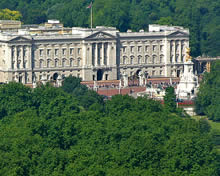
Advertisement
Commentary |
Select arrow to play/pause, bar to rewind/forward
Select arrow to play/pause, bar to rewind/forward
Highlights |
Front Facade
The Balcony
Changing of the Guards
Palace Interior Tour
Visitor Information |
Buckingham Palace is open daily, but only July to the end of September. Entry costs £15.50 per adult, £8.75 for children.
The Changing of the Guard
takes place in the forecourt of Buckingham Palace at 11.30am every day
in summer, every other day in winter, and lasts about 45 minutes.
Scrapbook |
Buckingham Palace
is the official London residence of Her Majesty the Queen and the Duke
of Edinburgh. It is here in the state apartments that Her Majesty
receives and entertains guests invited to the Palace.
The Palace was originally built in 1702 by the Duke of Buckingham
as his London town house. The Duke’s son sold the house and in
1774 Queen Charlotte lived here; the house then became known as The Queens House.
It passed to King George IV and he had the house extended into a
substantial palace, creating a new suite of rooms facing the garden, in
a French Classic style.
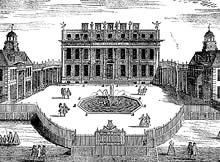
Buckingham House c1710
Source WikiMedia (PD)
The
first monarch to occupy the palace was Queen Victoria in 1837 and among
the many changes made at this time, was the removal of the huge arched
gateway to Tyburn, where it become known as Marble Arch.
Additions to the front of the building were made in 1913, including the
famous balcony where members of the royal family wave to the crowds on
special occasions.
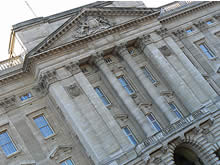
The famous Balcony
Did You Know?
The
palace chapel was hit by a bomb in World War II and subsequently royal
christenings have taken place in the Music Room. The Queen's first
three children were all baptised here in a special gold font. Prince
William was also christened in the Music Room; however, his brother,
Prince Harry, was christened at St George's Chapel, Windsor.
Taking you on a quick tour of the Palace; starting in the Grand Entrance Hall, we find the Grand Staircase with floral gilt-bronze balustrade, rising from the grand hall to the state rooms on the first floor.
Next is the Green Drawing Room,
which was the site of Queen Charlotte’s salon and has vibrantly
coloured silk walls with a beautifully coved and gilded ceiling.
Then there is the splendid scarlet and gold Throne Room, where you can see the thrones used at the coronation of Her Majesty the Queen in 1953.
The magnificent State Ballroom
is used for banquets and entertaining visiting heads of state. The room
was opened by Queen Victoria in 1856 to celebrate the end of the
Crimean war.
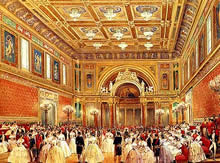
The State Ballroom in 1856 by Louis Haghe
Source WikiMedia (PD)
Moving into the Picture Gallery,
which is the largest room in the Palace, we discover wonderful art
treasures from the Royal Collection by Rubens, Rembrandt, Canaletto,
Van Dyck, Vermeer, and many others. You will also see portraits of
Kings and Queens such as George III and IV, in the State Dining Room.
In the Blue Drawing Room, note the thirty fake onyx columns and the Sevres porcelain table which was made for Napoleon.
From the semicircular bow window of the domed Music Room
you will have a good view of the garden and grounds. The Archbishop of
Canterbury has christened four royal babies in this room.
Perhaps most magnificent of all, is the White Drawing Room,
furnished with French antiques and English cut glass chandeliers
suspended from the beautiful ceiling, the delicate colours of the
furnishings standing out against the gold walls.
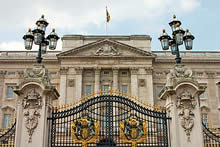
Buckingham Palace Gates
Photo © Jimmy Harris (CC)
Outside,
the large gardens contain a four acre lake and are a haven for many
kinds of wildlife. The gardens are used regularly for various parties
and events.
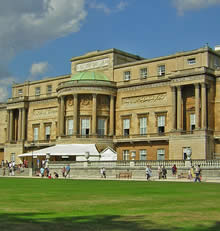
The rear of Buckingham Palace
Photo © Anubis3 (CC)
Did You Know?
On September 15, 1940 an RAF pilot, Ray Holmes, rammed a German plane
attempting to bomb the palace. Holmes had run out of ammunition and
made the quick choice to ram. Both planes crashed and their pilots
survived. The plane's engine was later exhibited at the Imperial War
Museum in London. Following the war the British pilot became a King's
Messenger. He died at the age of 90 in 2005.
One of the most famous events at the Palace is the changing of the guard
which takes place most mornings. You will see the guards, dressed in
red tunics and black bearskin hats, marching to the front of the palace
from nearby Wellington Barracks.
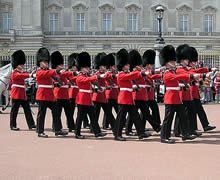
Changing the Guard
Source WikiMedia (PD)
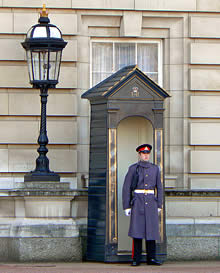
Guarding the Palace
All
logos are registered trademarks and copyright their owners. Items
marked (CC) are licenced using a Creative Commons licence by-sa. Items
marked (PD) are in the public domain and sourced from WikiMedia. All
other content is Copyright Pocket Places Ltd, unless stated otherwise.
